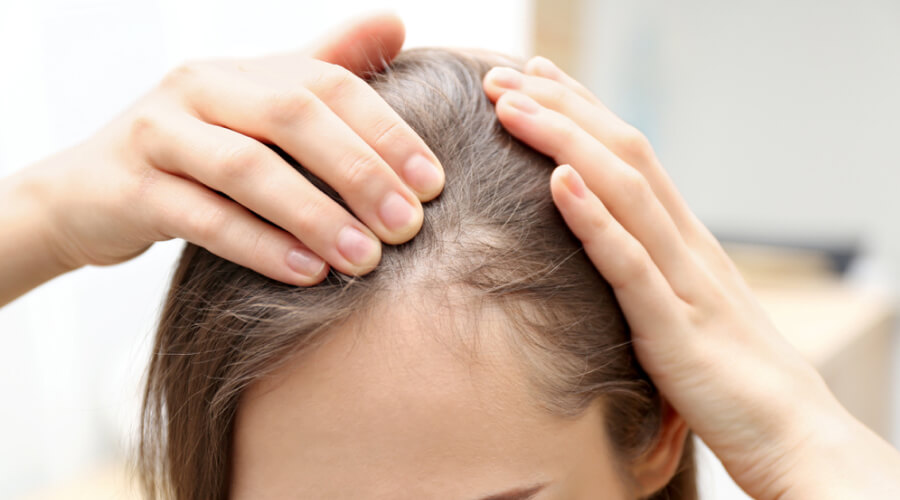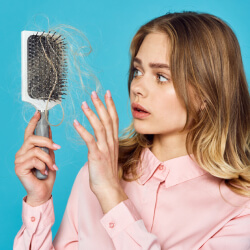For Women
Hair loss is common. It doesn’t only affect men, but women, too. In the process, you may find yourself feeling startled, frustrated, and less confident—and that’s completely understandable.
Why Am I Losing Hair?

The tug-of-war with hair loss can drag your self-esteem and confidence down. And while hair loss is common, it isn’t exactly entertaining to talk about.
You shed around 50-100 hairs a day, and new hair growth usually sustains a full head of hair.
But hair loss becomes more common, especially as you advance in age. More than half of women will experience noticeable hair loss at some point in their life, where they lose more hair than they grow.
Female pattern hair loss, or androgenetic alopecia, is one cause of hair loss in women. You may notice thinning hair and hair loss from anywhere on the scalp. It usually starts at your part line, but you’re less likely to experience complete baldness than men.
Female pattern baldness may be attributed to:
- Genetics: If you have a family history of hair loss, you may inherit the balding genes from either parent.
- Hormones: Hair loss commonly arises after menopause. Hence, hormones are thought to play a part in it.
- Aging: Female pattern baldness more commonly affected women advanced in age. But it can still begin at any stage of life.
Other Common Reasons For Hair Loss in Women
Your hair loss may be caused by various reasons.
- Tight hairstyles that pull on your roots
- Lack of certain vitamins or an overly restrictive diet
- Some medications, supplements, or chemotherapy
- Giving birth
- Hormonal changes resulting from menopause, pregnancy, or contraceptive pills
- Medical conditions, including specific autoimmune diseases
If you’re unsure of the cause of your hair fall, it’s best to consult a dermatologist or healthcare provider on the most likely reason behind it.
Minoxidil is the only FDA-approved medication for female pattern baldness.
Getting treatment the soonest you can halt the hair loss process quicker.

How Minoxidil Tackles Female Pattern Baldness
Minoxidil cannot lead to a complete restoration of your hair. Still, many women have seen significant improvement with use.
Topical minoxidil can slow and even stop the balding process. Plus, it may also encourage new hair growth. Altogether, these effects give you a fuller head of hair.
The exact mechanism behind how minoxidil works for hair loss is not well-understood. But minoxidil is thought to nudge hair follicles into the active stage earlier (anagen phase) and extend this phase of the hair growth cycle. Plus, minoxidil may combat the shrinkage of hair follicles.
These mechanisms work together to stimulate new hair growth, treat hair loss, and slow down the hair loss process.
Minoxidil For Women
Minoxidil treats female pattern baldness.
You’ll find topical minoxidil available in a foam or liquid formulation. You may use the minoxidil 2% solution or minoxidil 5% foam.
The minoxidil 5% solution has yet to be approved for use in women. There are cases of women using it off-label. But this is best done only under the supervision and advice of your doctor.
As of now, minoxidil is the only medication approved by the FDA to treat female pattern baldness. Many women using minoxidil for this type of hair loss notice they stop losing hair and grow new strands.
Yes, minoxidil is safe for women as long as the directions of use are followed. Topical minoxidil for hair loss is less likely to cause serious side effects compared to oral minoxidil taken for high blood pressure.
Currently, topical minoxidil is not recommended for use in pregnant women. If you are pregnant or breastfeeding, seek your doctor’s advice before starting on minoxidil.
Topical minoxidil may cause stinging and redness at the site of application. Rarely, minoxidil applied to your skin may be absorbed into your body. These may lead to more serious side effects such as unwanted hair growth, dizziness, fainting, or chest pain. These side effects are not common with topical minoxidil. But you should seek immediate medical attention if you experience any of them.
Minoxidil for men is available in a 5% solution or 5% foam. However, minoxidil formulations approved for women are only the 2% solution and 5% foam. Minoxidil 5% solution is not approved for women right now.
Minoxidil is usually used twice daily. It’s best to follow the instructions and directions given or seek the advice of your health professional if you’re unsure.
Minoxidil may help your hair grow longer at a faster rate, but its main treatment indication is to give you a fuller and thicker head of hair. It does so by stimulating new hair growth and stopping or slowing the hair loss process.
Other Hair Loss Treatment Options For Women
- Laser treatment
- Hair transplant
- PRP treatment
- Spironolactone
- Estrogens
- Steroids
- Finasteride
The medications on this list have been studied for their efficacy in treating women’s hair loss, but has yet to be approved for widespread treatment use.